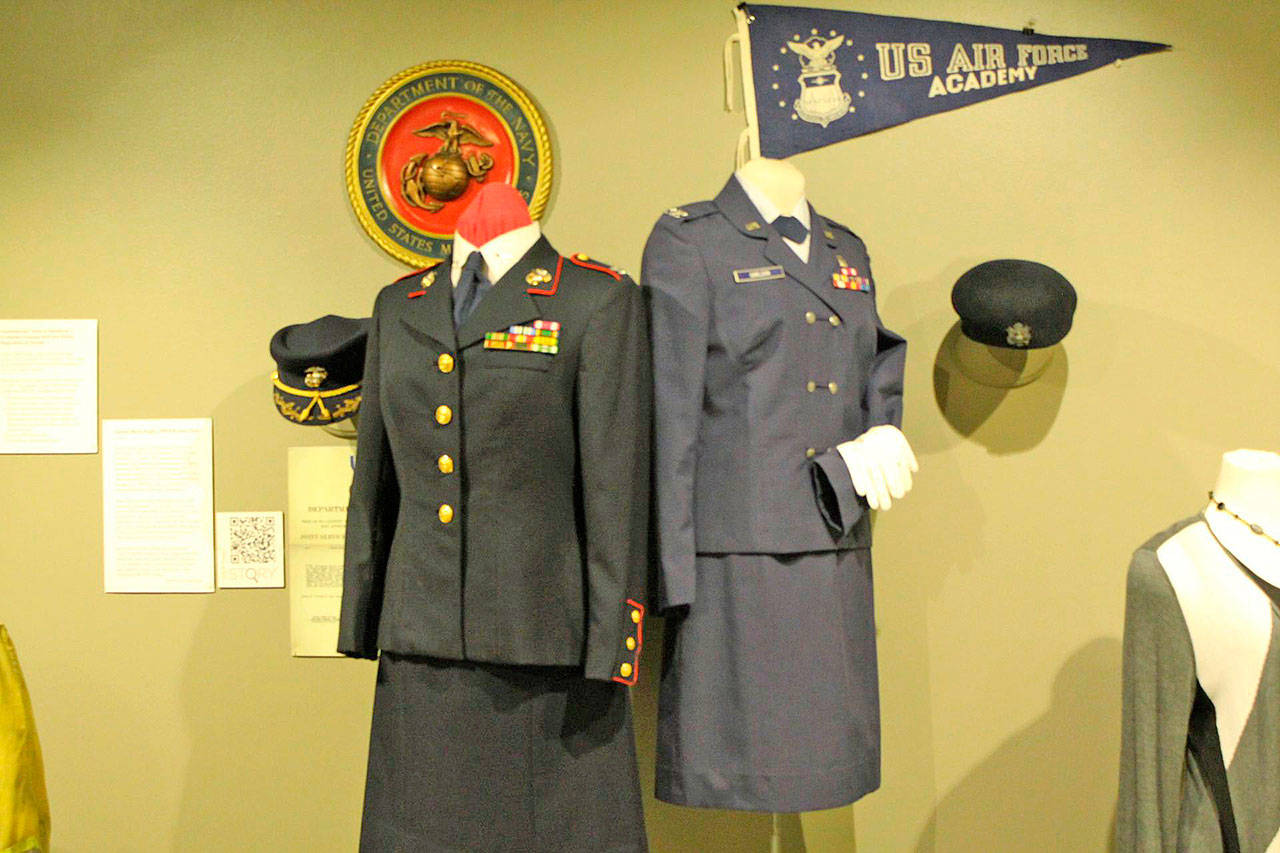By Brandon Gustafson/For the Auburn Reporter
One side of the room holds the uniform of the highest-ranked female Marine during the Vietnam War, including pumped shoes, hose and a girdle, while her male counterparts wore more comfortable fatigues.
Hanging on a wall are 11 tips for men managing women in the workplace from 1943. Suggestions for these men included hiring “husky girls” as well as giving women a day-long schedule so they will be less likely to bother the management.
These artifacts, and many more, are on display at White River Valley Museum in Auburn, in a temporary exhibit titled, “Women at Work: Uniforms and Work Wear 1910-2010.”
The exhibit, which runs through June 18, includes work uniforms of women who were teachers, in the military, flight attendants, and more. Many of these uniforms come from the private collection of Alice Miller and her husband, Steve.
“We do a show on women’s history every other year or so,” Patricia Cosgrove, the director of White River Valley Museum said. “Usually we tackle the subject by looking at fashion, as it is an easily understood way to get into the story of people’s lives, their roles in society, daily activities. We learned about the collection of military uniforms owned by Alice Miller, and that was the beginning of this idea.”
Miller, a nurse, said that she grew up in a military family, and that she was interested in nurses who had served in past wars.
“Some of the nurses that were actually my mentors that I worked with were actually World War II nurses,” Miller said. “We would talk about their service, and one gal showed me her uniform and she let me borrow it, and I said, ‘Well, this is pretty cool.’”
Miller took care of nurses who had served in World War I, and said that she loved talking to them about their time in the service and progressively started collecting more uniforms.
“One day somebody said to me ‘Why don’t you come to this school and do a display?’” Alice Miller said while laughing. “I said, ‘A display? A display with what?’ and she said, ‘With some of the uniforms that you have! Wear them for the kids or bring them on hangers!’”
Miller’s first exhibit with the school had three uniforms. She sent pictures to her sister, who was in the Air Force, and loved it. The success and affirmation from her sister led Miller and her husband to collect more memorabilia and assist in exhibits like “Women at Work” to which they contributed roughly half of the artifacts.
Changing look
“Women make up the bulk of our world, yet are little studied, understood, or featured in most media and educational programs,” Cosgrove said. “At least 51 percent of our potential viewers have a one-on-one, direct relationship to the subject of women at work. “Over the past 100 years or so, women’s lives have changed greatly, and this exhibit shows a very clear view of those changes.”
An example of this can be seen in the uniforms of flight attendants.
Flight attendants in the 1960s wore paper dresses and heels while customers were given paper dolls in the attendants’ likeness. The requirements for women to get hired for this job included being between 5 feet tall and 5 feet 4 inches tall, 20 to 26 years old, and weighing between 100 and 118 pounds. These women also had to be registered as nurses, had to be single, and could be fired if they got married.
“The women featured in this exhibit are really everyday women, but they carried on under some extraordinary challenges. I think women’s history is full of this kind of story and is well worth telling and appreciating,” Cosgrove said. “I really do not think that men comprehend the day-to-day challenges experienced even today by women in the workforce. Challenges not experienced by their male counterparts.”
The exhibit has been a success thus far, according to Miller, who said that one woman from out of state has come back twice and told her how much she enjoyed it.
This has been reaffirmed by Rachel McAlister, the museum’s Curator of Education.
“I’m not sure about the attendance numbers, but I have witnessed a lot of people in the gallery having a great time,” McAlister said.
McAlister personally likes the “Hello Girl” uniform belonging to Satie M. Brown, which is the first uniform you’ll see when you walk in the exhibit. “Hello Girls” would help translate French during World War I so the French and American forces could communicate with one another, and would only get to have this job by paying their way to France and for their uniforms after being accepted.
Stories like Brown’s are all throughout the exhibit, offering insight into women’s roles in the past.
“It’s a wonderful exhibit that provides unique insights into the hardships and triumphs of women in the workforce,” McAlister said. “My hope is that guests will exit the exhibit with a feeling of pride and respect for pioneering women, a sense of empathy for those who continue to trail blaze as well as those who struggle, and that they leave with a little touch of personal empowerment for what they, too, can accomplish.”
Alice Miller has served as a guest curator of the exhibit once already, and will do again on June 10.
ONLINE: For more information on the White River Valley Museum, its exhibits, programs, hours and admission prices, visit wrvmuseum.org.


